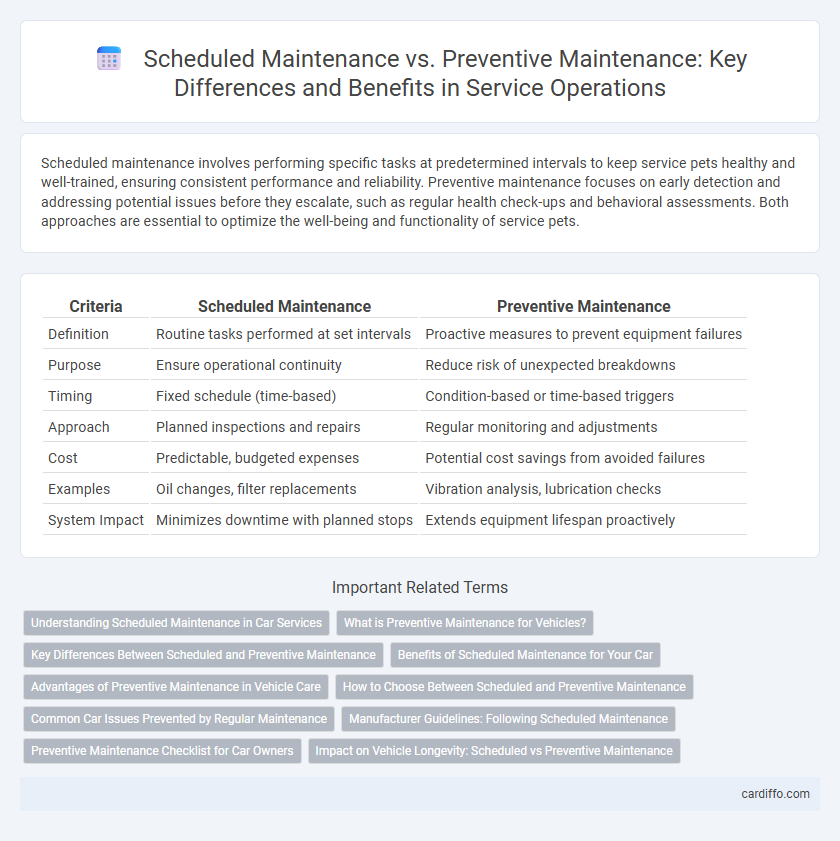Scheduled maintenance involves performing specific tasks at predetermined intervals to keep service pets healthy and well-trained, ensuring consistent performance and reliability. Preventive maintenance focuses on early detection and addressing potential issues before they escalate, such as regular health check-ups and behavioral assessments. Both approaches are essential to optimize the well-being and functionality of service pets.
Table of Comparison
| Criteria | Scheduled Maintenance | Preventive Maintenance |
|---|---|---|
| Definition | Routine tasks performed at set intervals | Proactive measures to prevent equipment failures |
| Purpose | Ensure operational continuity | Reduce risk of unexpected breakdowns |
| Timing | Fixed schedule (time-based) | Condition-based or time-based triggers |
| Approach | Planned inspections and repairs | Regular monitoring and adjustments |
| Cost | Predictable, budgeted expenses | Potential cost savings from avoided failures |
| Examples | Oil changes, filter replacements | Vibration analysis, lubrication checks |
| System Impact | Minimizes downtime with planned stops | Extends equipment lifespan proactively |
Understanding Scheduled Maintenance in Car Services
Scheduled maintenance in car services involves performing routine checks and replacements at predetermined intervals based on the manufacturer's guidelines to ensure optimal vehicle performance and safety. This type of maintenance includes oil changes, tire rotation, brake inspections, and fluid top-ups, which help in detecting issues before they escalate into major problems. Adhering to scheduled maintenance improves engine efficiency, extends vehicle lifespan, and maintains warranty validity.
What is Preventive Maintenance for Vehicles?
Preventive maintenance for vehicles involves regularly scheduled inspections and servicing designed to identify and address potential problems before they cause major breakdowns. It includes activities such as oil changes, brake inspections, tire rotations, and fluid checks to ensure optimal vehicle performance and extend its lifespan. This proactive approach reduces the risk of unexpected failures, minimizes repair costs, and enhances overall safety on the road.
Key Differences Between Scheduled and Preventive Maintenance
Scheduled maintenance involves servicing equipment at pre-determined intervals based on time or usage, ensuring consistent upkeep regardless of current condition. Preventive maintenance focuses on identifying and addressing potential issues before they cause equipment failure, typically guided by condition monitoring and inspection data. Key differences include scheduling rigidity, with scheduled maintenance being time-based, while preventive maintenance is condition-driven and aims to proactively reduce downtime.
Benefits of Scheduled Maintenance for Your Car
Scheduled maintenance ensures timely inspections and replacements based on manufacturer recommendations, reducing the risk of unexpected breakdowns and costly repairs. It improves vehicle safety and performance by addressing wear and tear before major issues arise. Consistent scheduled services also help maintain the car's warranty and resale value by keeping maintenance records up to date.
Advantages of Preventive Maintenance in Vehicle Care
Preventive maintenance in vehicle care significantly reduces the risk of unexpected breakdowns by addressing potential issues before they escalate, enhancing overall vehicle reliability and safety. This approach extends the lifespan of critical components such as engines, brakes, and tires, leading to lower long-term repair costs compared to scheduled maintenance. Regular inspections and timely replacements during preventive maintenance optimize fuel efficiency and maintain optimal vehicle performance.
How to Choose Between Scheduled and Preventive Maintenance
Choosing between scheduled and preventive maintenance depends on equipment criticality, risk tolerance, and operational goals. Scheduled maintenance follows a fixed timetable based on manufacturer recommendations or usage intervals, ideal for predictable wear patterns. Preventive maintenance leverages condition monitoring and predictive analytics to address issues proactively, reducing unexpected downtime and extending asset lifespan.
Common Car Issues Prevented by Regular Maintenance
Scheduled maintenance and preventive maintenance target common car issues such as engine overheating, worn brake pads, and battery failure by ensuring timely oil changes, brake inspections, and battery checks. Regular maintenance also prevents tire wear and alignment problems, reducing the risk of blowouts and uneven handling. Addressing these issues proactively extends vehicle lifespan and maintains optimal performance.
Manufacturer Guidelines: Following Scheduled Maintenance
Scheduled maintenance strictly adheres to manufacturer guidelines, ensuring all inspections, adjustments, and replacements occur at recommended intervals for optimal equipment performance. This approach minimizes unexpected breakdowns by proactively addressing wear and tear based on the manufacturer's expertise and predefined schedules. Following scheduled maintenance helps maintain warranty validity and extends the lifespan of machinery through consistent, guideline-driven care.
Preventive Maintenance Checklist for Car Owners
A Preventive Maintenance Checklist for car owners includes regular oil changes, tire rotations, brake inspections, and fluid level checks to ensure optimal vehicle performance and safety. Monitoring battery health, replacing air filters, and inspecting belts and hoses are essential tasks that reduce the risk of unexpected breakdowns. Following this checklist systematically extends engine life, improves fuel efficiency, and minimizes costly repairs over time.
Impact on Vehicle Longevity: Scheduled vs Preventive Maintenance
Scheduled maintenance follows manufacturer-recommended timelines and specific service intervals to ensure consistent vehicle performance and reduce unexpected breakdowns. Preventive maintenance proactively addresses potential issues before symptoms arise, significantly enhancing vehicle longevity by minimizing wear and tear. Vehicles receiving preventive maintenance often experience extended engine life, improved fuel efficiency, and lower overall repair costs compared to those maintained solely on scheduled guidelines.
Scheduled Maintenance vs Preventive Maintenance Infographic

 cardiffo.com
cardiffo.com